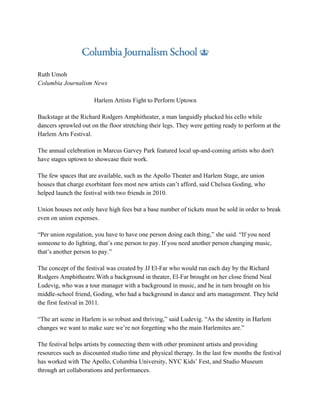HarlemArtsFestival1
- 1.
Ruth Umoh
Columbia Journalism News
Harlem Artists Fight to Perform Uptown
Backstage at the Richard Rodgers Amphitheater, a man languidly plucked his cello while
dancers sprawled out on the floor stretching their legs. They were getting ready to perform at the
Harlem Arts Festival.
The annual celebration in Marcus Garvey Park featured local upandcoming artists who don't
have stages uptown to showcase their work.
The few spaces that are available, such as the Apollo Theater and Harlem Stage, are union
houses that charge exorbitant fees most new artists can’t afford, said Chelsea Goding, who
helped launch the festival with two friends in 2010.
Union houses not only have high fees but a base number of tickets must be sold in order to break
even on union expenses.
“Per union regulation, you have to have one person doing each thing,” she said. “If you need
someone to do lighting, that’s one person to pay. If you need another person changing music,
that’s another person to pay.”
The concept of the festival was created by JJ ElFar who would run each day by the Richard
Rodgers Amphitheatre.With a background in theater, ElFar brought on her close friend Neal
Ludevig, who was a tour manager with a background in music, and he in turn brought on his
middleschool friend, Goding, who had a background in dance and arts management. They held
the first festival in 2011.
“The art scene in Harlem is so robust and thriving,” said Ludevig. “As the identity in Harlem
changes we want to make sure we’re not forgetting who the main Harlemites are.”
The festival helps artists by connecting them with other prominent artists and providing
resources such as discounted studio time and physical therapy. In the last few months the festival
has worked with The Apollo, Columbia University, NYC Kids’ Fest, and Studio Museum
through art collaborations and performances.
- 2.
“We almost act like an agency in terms of presenting people … and enhancing their visibility,”
said Ludevig.
The Harlem Arts Festival had 116 volunteers at this year’s event, held June 25 26, and has
presented over 200 artists since 2012. The artists are seen by some of New York’s leading arts
institutions such as The Apollo, The Hip Hop Theater Festival, and Alvin Ailey Dance Theater.
With 15 volunteers, the organization also hosts open mics, exhibitions for visual artists,
workshops, and educational partnerships with Harlem School for the Arts, where artists are able
to talk to students. The organization has garnered support from Harlem cultural leaders such as
Voza Rivers, chair of the Harlem Arts Alliance who sits on the Festival Advisory Board, and
Simone Eccleston, interim director of Harlem Stage, who is part of the festival’s artistic selection
committee.
Goldman Sachs and Con Edison have sent volunteers to the event in the past and Green
Mountain Energy has signed up to sponsor the festival for three years. The Harlem Community
Development Corporation also pledged $5000 in 2015 which it quadrupled this year.
Despite a torrential downpour that dampened last year’s festival, it still managed to draw about
1,500 people and 30 to 40 vendors. This year there were about 6,000 attendees, 50 vendors, and
43 artists participating.
Marcus Garvey Park, at East 120th Street to East 124th Street, is home to the Richard Rodgers
Amphitheater, which seats 15002000 people and is the second largest amphitheater in New
York City, after the Delacorte Theater in Central Park.
“Marcus Garvey Park is the heart of Harlem,” said Goding. “East and West Harlem are split by
the park so it’s geographically central to Harlem. It’s the epicenter of free cultural life.” The
park also has a swimming pool, playground and fountains.
On the main stage of the theater, musician Billie Dean Thomas rapped about growing up in
Harlem as a lesbian and pursuing her dreams: “I’m the queer B.I.G. … Dollar in my dream. First
class the only category I redeem.”
The festival weekend also featured poet Alphonso Kenny, who goes by the moniker Smoove
Babii.
- 3. Kenny took part in the Spoken Word segment of the festival. He got into poetry in November
2010 when his grandmother died. “My grandmother was an outlet when I needed someone to
talk to,” he said in an interview.
Until a week ago he wasn’t sure if he was going to perform because his older brother was
recently killed. He said his family pushed him to go through with the festival. “I want people to
see the realness and the passion behind [my poetry]. I don’t hide behind big words. It’s raw and
uncut.” His poetry deals with his personal struggles in the Bronx and police brutality.
MC Justin Gerell, who introduced jazz group Shereef Keys, wore a shirt saying, “I love my
history. I love my culture. I love my people. I love me.”
Collagist Ian Brown and other artists at the festival celebrated their Black heritage. Brown said
he makes art to open people's eyes. His work features Black emperors, powerful Black figures,
and aims to make people aware of the contributions of the Black Diaspora, he said.
The Movement Theatre Company also appeared. Eric Lockley, founder of the company, noted
that many comedians live uptown but must travel downtown or to Brooklyn to perform.
“It’s the idea that we want to say your voices are important and we want to give them that
platform and that comedic space uptown,” said Lockley. He hopes to one day build a space in
Harlem where young artists can perform.
Over the weekend, the Theatre Company featured Laugh out Loud (LOL) an improv series by
comedic groups Affirmative Action, an allfemale minority group, and CPT, Comedic People’s
Time, a play on the acronym many black people use in jest, “Colored People’s Time.”
The festival will continue to push for more affordable uptown platforms to showcase art. Until
then, there’s always Marcus Garvey Park.
Ruth Umoh
Columbia Journalism News

